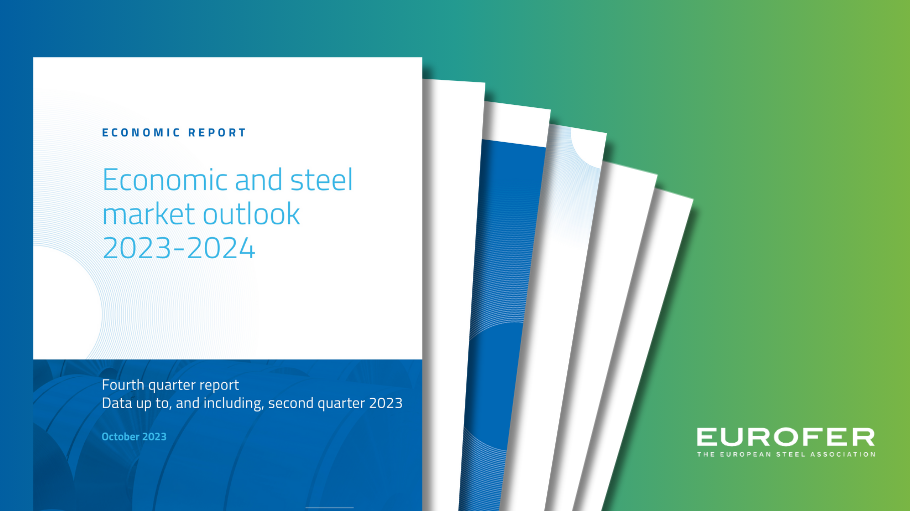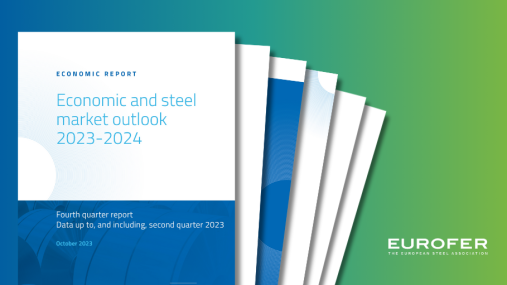
Publications » Economic and market outlook » Economic and steel market outlook 2023-2024, fourth quarter
Economic and steel market outlook 2023-2024, fourth quarter
Downloads and links
Recent updates

The severe consequences of the war in Ukraine and the deteriorating overall economic outlook continue to take their toll on apparent steel consumption in 2023. After a significant recession (-7.2%) in 2022, persistent downside factors such as ongoing conflicts, uncertainty surrounding energy prices and high inflation, combined with a worsened economic outlook, are set to negatively impact again apparent steel consumption in 2023, for which the forecast indicates a more pronounced contraction (-5.2%) compared to the previous outlook (-3%). This would mark the fourth annual recession in the last five years. In 2024, conditional on more favourable developments in the industrial outlook and increased steel demand, apparent steel consumption is projected to recover at a faster rate (+7.6%, up from the former estimate of +6.2%).
The overall evolution of steel demand remains subject to very high uncertainty. Quarterly improvements in apparent steel consumption are not expected before the fourth quarter of 2023.
In the second quarter of 2023, apparent steel consumption dropped for the fifth consecutive quarter (-7.6%), after shrinking in the preceding quarter (-11.3%). The total volume reached 35.6 million tonnes, showing improvement compared to the first quarter of 2023, but still falling short of levels seen in 2021 and the first half of 2022. The current downturn in EU apparent steel consumption began in the second quarter of 2022, due to war-related disruptions, unprecedented rises in energy prices, production costs and inflation, all amid growing economic uncertainty. Demand conditions have significantly worsened in the latter half of 2022, and this negative cycle is expected to continue at least until the third quarter of 2023 included, driven by ongoing economic uncertainty resulting from high inflation.
Domestic deliveries have continued to mirror weak demand in the second quarter of 2023, declining (-6.5%) for the fifth consecutive time but at a slightly more pronounced pace than in the first quarter (-6.2%). In 2021, deliveries had rebounded significantly (+11.9%), after the sharp drop in 2020 (-9.6%) and the already negative performance in 2019 (-4.2%). As a result of the unfavourable developments in the last two quarters of the year, in 2022 domestic deliveries markedly dropped (-7.9%).
In line with the continued deterioration in steel demand, imports into the EU including semi-finished products similarly shrank in the second quarter of 2023 (-10.2%), albeit at a slower pace than in the preceding quarter (-26.6%). However, it is essential to note that the recent drops in imports are primarily a reflection of weak demand conditions. Therefore, the share of imports out of apparent consumption has remained considerably high in historical terms, even in the second quarter of 2023 (28%).
Despite Russia’s invasion of Ukraine and above-average energy prices, EU steel-using sector’s output continued to grow up to the second quarter of 2023, displaying unexpected resilience. The Steel Weighted Industrial Production index (SWIP) increased further (+0.8%, following +2.6% in the first quarter of 2023).
The more-than-expected positive trend in all sectors’ output in the second quarter of 2023 was a combination of continued, favourable developments in the automotive, mechanical engineering and transport sectors on one hand, and a decrease in domestic appliances, tubes and metalware output on the other. The construction sector, as anticipated, entered recession and recorded its third consecutive quarterly decline (-2.5%, after +0.5%). The recessionary trend is expected to persist. The overall positive trend in SWIP started after the pandemic had continued so far in spite of soaring energy prices impacting production costs, component shortages and lower output that took their toll on total production activity in steel-using sectors in the second half of 2022.
The deterioration of the economic and industrial outlook in the EU – especially due to high inflation and the subsequent interest rate hike by the European Central Bank (ECB) – has had a limited impact on steel-using sectors’ output so far. The construction sector, which accounts for 35% of steel consumption in the EU, is the only significant exception.
The ongoing economic uncertainty is set to continue affecting growth over the upcoming quarters. Despite EU industry having weathered the toughest quarters on record (Q4 2022 and Q1 2023), the remainder of 2023 appears to be characterised by a combination of uncertainties in energy prices, weak demand, inflation and economic challenges driven by high interest rates.
While output grew more than expected (+3%) in 2022, the SWIP index for 2023 is forecasted to slow down more significantly than expected (+0.6%, previous forecast +1.3%), albeit with wide differences among individual EU economies. In 2024, steel-using sectors’ growth is projected to decelerate once again (+0.4%), due to a likely downturn in the automotive sector.

Download this publication or visit associated links
Brussels, 07 May 2024 – The European Commission has today published two Regulations extending the anti-dumping and countervailing measures in force on imports of stainless steel cold-rolled flat products (SSCR) originating in Indonesia to imports of SSCR from Taiwan, Turkey and Vietnam. EUROFER welcomes the extension of the duties and the introduction of import requirements connected to strict monitoring of imports.
The outlook for the European steel market in 2024 continues to lose momentum amidst persisting challenging conditions. Downside factors such as worsening geopolitical tensions, coupled with growing economic uncertainty, energy prices, inflation, interest rates have further impacted demand prospects. According to EUROFER’s latest Economic and Steel Market Outlook, these challenges have exacerbated the negative effects on apparent steel consumption, resulting in a more severe downturn in 2023 than previously projected (-9%, instead of -6.3%) and weaker growth in 2024 (+3.2%, instead of +5.6%). Output in steel-using sectors, despite showing more resilience than expected in the past year (+1.1%), is now set to decline (-1%). Imports are once again on the rise (+11% in the last quarter of 2023), capturing a staggering 27% market share throughout 2023.
Second quarter 2024 report. Data up to, and including, fourth quarter 2023